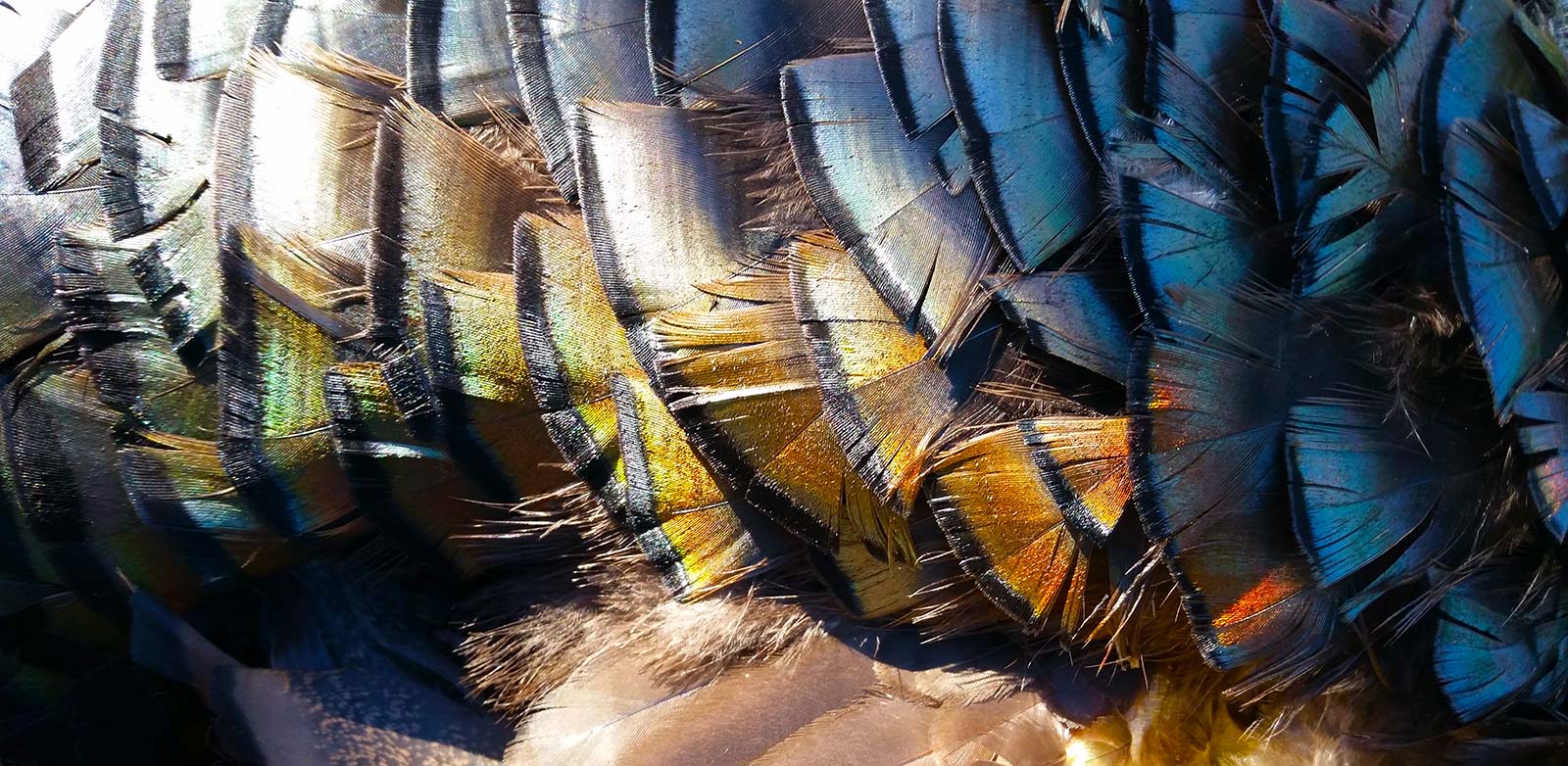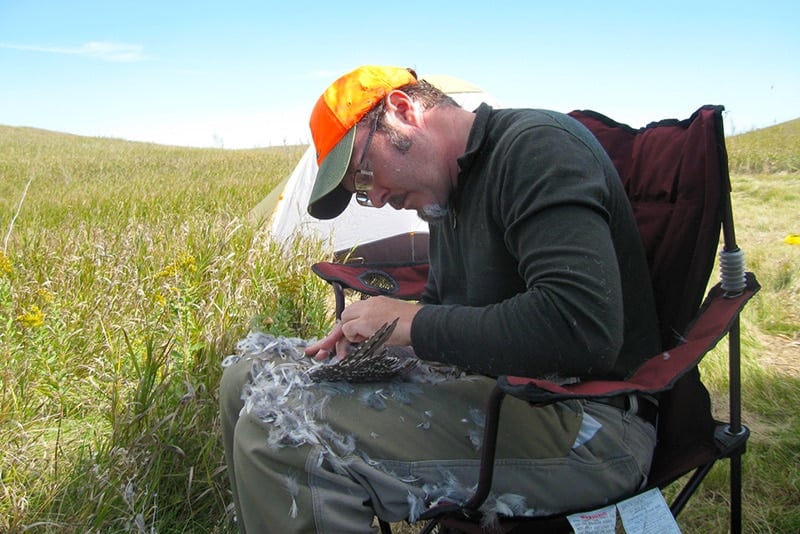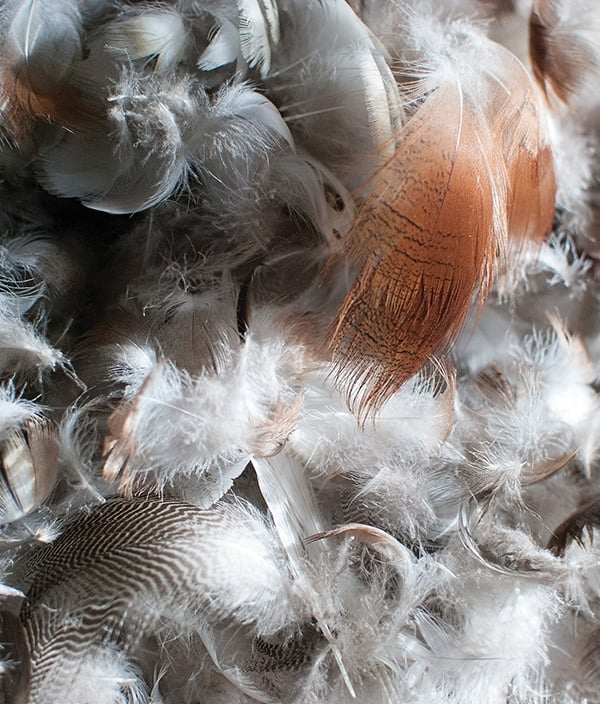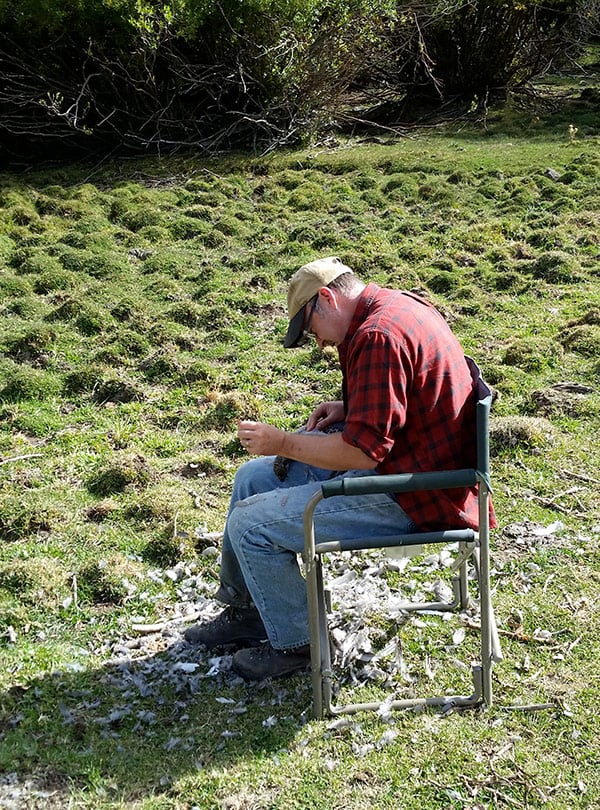As an Amazon Associate I earn from qualifying purchases.

I’ve picked an inordinate number of grouse this fall. Sage grouse, sharpies, blue grouse, prairie chickens. Throw in some mountain quail and a bucket of doves, plus one pigeon, and you can say I’ve been quite the mother plucker this year. And duck season hasn’t even started yet.
I am here to make the case for plucking birds.
Plucking a bird is an act very much like unearthing an archaeological treasure. It can be a painstaking business, frustrating, messy and yet, when you are done, deeply rewarding. It is an act of love, in an odd way. You are working hard to bring out the best in your birds.
For me it is a calming process, a task I can zen out on, focusing only on the next feather. Plucking occupies the same mindspace for me as making pasta: Mindless, yet highly focused.
Hunters out there, I know, I know. I can feel your skepticism through the interwebz. And I can almost hear you say it… “You pluck all your birds?!” For the most part, yeah, I do. If I had a dollar for every time I heard someone say that, I’d have enough money to buy a new shotgun.

Those of you who raise chickens or turkeys or ducks know that you must pluck your birds for the market because we, as consumers, simply would not buy a skinned chicken or turkey. (Yes, I know there is a large market for skinless, boneless chicken breasts. But those are mostly eaten by people who hate food.) And can you imagine someone selling duck breasts without all that yummy fat and skin? Heresy.
Hunters, you owe it to yourself to pluck your birds. I don’t want to sound scolding or holier-than-thou, but eating a beautiful plucked pheasant or quail or duck is one of life’s great joys at the table, and it really is worth the effort.
What’s the big deal? Almost all of a bird’s distinctiveness resides in the skin and fat. I’ve written extensively on the relationship between fat and flavor elsewhere, but suffice to say that if you skin your birds you will have an awfully hard time telling a bite of coot breast apart from a bite of canvasback breast. Honestly. And trust me, I’ve done blind tests.
I just did a test a couple weeks ago, where I served some friends slices of pintail, canvasback and mallard breasts — all with skin and fat. Everyone preferred the pintail, but the canvasback was a universal second. The mallard was, well, boring. None of this would be discernable without skin and fat, and you cannot get skin and fat on a bird without plucking.
But even I do not pluck every single bird I come home with. So, when to pluck and when not to? Here is what I do:
- If the bird has been terribly shot up or mauled by your dog, or. God forbid, someone else’s, skin it.
- Wingshot birds will often have pristine breasts, so always pluck them.
- Pluck “quality” ducks and geese — mallards, black ducks, pintail, canvasbacks, teal, specklebelly geese and, in certain cases, wigeon, gadwall, redheads, bluebills and Canada geese.
- For the most part, skin snow geese, which have weird blue skin and almost no fat; there are exceptions to this, as I’ve written about here. Skin all sea ducks or divers shot near salt water, again, with rare exceptions. They will almost always taste fishy. If you eat coots, skin them, too.
- The rarer the quarry, the most important it is to pluck it. You might not get too many ruffed grouse or sandhill cranes or woodcock, so be sure to enjoy everything that bird has to offer by plucking it.
How to Start?
To dry pluck, all you need is patience and a good set of kitchen shears. The shears are to clip the wingtips (even I don’t bother plucking the last section of a bird’s wings) and to chop off the bird’s head.
To wet pluck, you will need slightly less patience, a good set of kitchen shears, and a really big canning pot. If you are plucking waterfowl, you will also need several pounds of wax (more on that in a bit). I use Parowax Household wax, which you can usually find in canning sections of most supermarkets.
Now that you have the equipment, here’s how I pluck various game birds.
For starters, always pluck before gutting the birds. (You’d be surprised how often I get that question.)
As for various bird species, I’ve already written a tutorial on how to pluck a pheasant. These instructions work for all gallinaceous birds: pheasants, partridges, turkeys, quail, grouse of all varieties — and yes, chickens. Know that ruffed grouse, sharp-tailed grouse and quail skin is unusually tender, and that turkey skin is pretty damn tough. Other than that, they’re all pretty much the same.
Doves and pigeons are the easiest birds to pluck. Once you get the hang of it, you can pluck a dove in about 2-3 minutes. Always dry pluck doves and pigeons. (Here’s our video on plucking doves.)
Woodcock should also be dry plucked. Snipe are persnickety to pluck (say that five times fast!), and I often wax them like ducks, but woodcock are nearly as easy as doves and pigeons.

Waterfowl are a different case. Ducks and geese require their own techniques for plucking.
On the plus side, their skin is pretty tough, so you are less likely to tear it compared to plucking a pheasant or quail. On the down side, is, well, down. Waterfowl have a layer of gossamer down under their regular feathers that keeps them warm and waterproof. It is not easy to get off by hand.
You can dry-pluck any waterfowl, but it will take longer than it would for a comparably sized upland bird, and you must deal with the fact that the wing feathers are extremely difficult to pull out. Think about it: Ducks fly thousands of miles in their migrations, while pheasants rarely fly at all, and when they do they fly only short distances. (Here is my video on dry plucking a duck.)
Wet-plucking is the way to go, only with a twist. I pluck all my ducks with the aid of canning wax, or paraffin. We go through many blocks of it each year, so stock up. The trick is to get a giant pot of water steaming – not boiling – melt wax in it, and dunk your birds. Toss the waxed birds in another basin of ice cold water to set the wax, let them cool a bit and pluck away. The wax grabs the down and upper feathers, leaving you with a nice clean plucked duck.
While your pot of water heats up, examine your ducks and geese. Chop off badly damaged legs or wings. Now rough-pluck your birds. Pull out the tail feathers, the big wing feathers (you might need to go one by one with geese), and some of the regular feathers on the body of the bird. Be careful when you do this, and anchor the skin of the duck with one hand while you pluck with the other.
Put the wax in the water. How much? Our paraffin comes four blocks to a box, and we find that a goose needs a full block. Big ducks need half, and on smaller ducks you can get away with 2 to 3 to a block.

Once the birds are rough-plucked and the wax is melted, grab the bird by the head and dunk it up to its neck in the water. Swirl it around a bit on the surface, too, and make sure you get it well coated. Let it drip a little over the pot, then put the waxed bird into a basin of cold water; we use our slop sink in the garage. Let the bird chill for a few minutes, then put it somewhere to drain.
Wear an apron or something when plucking, because it is a messy, wet business. Start with the wings, as they are the hardest part. You might need to break the wax seal on parts of the bird to peel off the wax. Again, anchor the skin with one hand while you peel with the other. Many times you are actually keeping the wax on one place while gently peeling the skin away from it – this is especially important when working around shotgun pellet holes.
After I do the wings, I go to the tail, then the back, then the legs. Finally, I do the neck and breast. The neck skin is loose, and this is the most likely place for a tear. The breast is the most prized part of the bird, so you will want your full attention here. It’s like opening a present: The breast gives you the best look at whether you have a fat bird or a skinny one. (Here’s a video of our wet-plucking process.)
So that’s it. That’s what I know about plucking game birds. But there are other ways out there.





Can you use the down feathers for anything if you use parowax? I was thinking about using your method to pluck and then reheating the down in boiling water to get rid of the wax.
Thank you for the videos on waxing ducks. We’ve been scalding and plucking them for awhile and last night we finally gave it a go with the wax. I had plucked too much of one of them before I saw the video so I had a really hard time getting the wax off, but the other bird was quite impressive.
Do you ever filter the wax to reuse? We were able to run it through a fine mesh cotton bag and it looks pretty clear. We’ll store it in the freezer and see how it is next time we give it a go.
We were just approved by our state to sell the poultry we raise and process on our little farm but we have no plucker, so having a way of dealing with ducks is important. For turkeys and chickens I’ve been dry plucking – I haven’t had a single problem with dry plucking and can’t understand why more people don’t do it. Nothing more gross than picking a hot, wet, dirty bird and getting feathers everywhere! Do you think waxing might work for chickens? I think we might be tempted to give it a go, just to make the process go quicker.
So, many thanks for the video. We know now to leave more feathers on!
Just finished plucking four widgeon from the last day of the season down here in Argentina and I must say your wax trick is a godsend! Thanks as always Hank for providing this great resource on the web. Now I’m off to the kitchen!
I’ve been a skinner for most of my days but you got me convinced to give this plucking thing a try. Calming….calming…calming…..
I’m a dry plucker when it comes to ducks and geese, mostly because I, also, save the down for future use in a pillow and comforter. That is, unless I get down to the breast and see that it’s all lean and no fat, or shot up too badly… then I get what down I can from it and then skin it out.
I also use the blow-torch method… I find that the smell doesn’t linger if you give the bird a good rinse after (assuming, of course, that you got all of the down burned off… )
I agree that a bird is best (generally) with the skin on, though. Do you “rest” your birds in the fridge, or hang them before plucking or do you rest them after their plucked and drawn?
Rose: Thanks for the tips! I may try scalding a duck with detergent this season…
Peter: Good on you for using the down! Never had the gumption to do that.
Laowai: AWESOME! Thanks for that explanation. This is why I love my readers!
Rachel Hoff mentioned that adding Dawn to the water made it get down to the skin. This makes sense scientifically. Adding soap to the water destroys the surface tension that keeps ducks floating and water skippers skipping (a fun way to check this out is put a floaty thing, like a leaf, in a glass of water and then add some soap to it: the leaf will sink). Surface tension depends on the strength water’s mutual molecular bonding. Adding the soap gets in the way of this bonding, making water even more slippery (even to itself), thereby allowing it to slip in between all the feather layers, soaking and scalding the feather roots, loosening them up.
I have no idea about the amount needed though. I’d guess too much would make the feathers slippery too and make it difficult to get a handle on them.
One thing you didn’t mention about dry plucking wild ducks, and that is the ease with which a well-fed bird’s plumage can come off just by rubbing your thumb against the lay of the plumage. That is true of all the puddle ducks and of most divers other than ruddies or golden eye (which I refuse to shoot). Not true of the wing feathers, obviously and as you point out.
Back in earlier days of late winter when the big ducks had laid on that heavy second coat of down I used to double pluck the breasts of mallard, sprig and widgeon, first taking off the outer feathers, Then, into a clean bag in the vacuum cleaner while it was running I’d do a second pluck for the down. In a couple of seasons I collected enough down that way for my wife to make a couple of down vests for our two little kids. Impractical? Sure. But satisfying to know I had got one more thing out of the duck? You bet.
We raise chickens, ducks, quail, turkeys and geese. We scald the chickens and turkeys at 145 degrees with a little bit of Dawn dishsoap in the water. The ducks and geese do better scalding at 158-160, and they need more soap in the water plus more time (agitating all along) to get the water fully penetrating into the feathers. It takes me about 30 minutes to pluck/gut a goose.
Our first time with geese (by far, the most difficult for us):
https://godfreyfamilyfarms.com/?p=238
and our second
https://godfreyfamilyfarms.com/?p=571
Neil: I don’t like the torch method because I think the burnt feather smell does linger on a bird. But that’s just me. As you can see, lots of people like it.
Mike: Ha! Yep, Holly shot that bird. You kill it, you pluck it…
Steve: Yep. I pluck most spoonies. I only skin them if they are really skinny or if they’re stinky. In the Sacramento Valley, most taste just fine, so they get plucked.
I don’t hunt and so don’t pluck game birds, but I do pluck the chickens we raise. There was a good article in Barkyard Poultry Mag (see: https://www.countrysidemag.com/issues/94/94-4/homestead_poultry_butchering.html) about a year ago. Using his method – wet scald at 140 degrees – I’ve had no trouble plucking the birds and getting clean results. Maybe game birds are different. That said, the next time I pluck I’m going to build a plucker I can power with my drill. I’m thinking a PVC end cap with a nut in the end to attach to the drill chuck and rubber plucking fingers around. Should be cheap – just like me.
What about spoonies? The fat on them often seems funky (yellow, chunky and off-smelling), but the skinned breasts taste fine.
Great post! Totally agree with the reasoning. Gave me a smile too. My husband grew up in Ireland, and he is “a feather plucker’s son”-say THAT five times fast! Seriously though, his father was a champion feather plucker. Talk about patience and skill!
great read as always, but that doesn’t look like you doing the plucking. 🙂
I agree with Mike that this would make a great video. I have to admit to this household being lazy and skinning our grouse and pheasant. I’m book marking this page and promise to pluck.
These are great instructions. My father taught me to wet pluck when I was a kid and it seems to get the job done but Patience is a virtue no matter what technique you use to pluck a bird.
Thanks Hank for this post.
-Me
Friendsfoodwine.com
Now why didn’t I see this BEFORE a group of guys gifted us three limits of ducks last week? That’s a lot of plucking. They also recommended the torch method. Thoughts on this? Will the meat pick up the singed flavor?
Chickens I have always plucked wet, these I did dry (cheated… plucking machine) and it wasn’t so bad, but it seems like wet is the way to go?
Sorry for all the questions, I’m totally new to waterfowl. On the up side, I never had to fire a shot. On the down side, I never fired a shot.
We raised ducks (not sure if I’ll ever do that again unless we get a larger property) and when we slaughtered them we wet plucked them. We didn’t use paraffin wax though. Instead we add some Dawn to the water, which helped get the hot water down to the skin then, like Steve, we use a propane torch to burn off any leftover feathers.
I think this would make an excellent video like your last one on how to clean gizzards. I’ve never plucked anything other than ducks and I made a mess of that the last time i shot one.
I have waited many years to find someone I agreed with on this issue, and we agree because of the same reasons.
From my early teens on, I have plucked everything I could, in spite of lots of comments. The first time I saw someone step on the wings and pull the feet of a ruffed grouse I had a fit. Yes, it is a quick and easy way to get the breast out, but no, thank you, I get all too few partridge to spare any meat. Yes, I do pick at the backs and drummies, and no, I don’t mind the mess.
Seeing perfectly plucked little green wing teal used to drive my brother crazy. He always wanted to skin them, but I noticed he was the first guy at the pot when it came time to eat them.
I became so seriously hung up on this that I would clean the other hunters ducks, a fact they soon took advantage of, but it drove me nuts to see guys waste the best part of a duck.
The only place we part company is on the waxing. I use a propane torch to get rid of the hair; it is only when we run into some local mallards with a lot of pin feathers that I will resort to wax.
As a matter of fact, it was on this blog that I first saw the use of a neck as a sausage casing. That column alone has sold you a few books, Hank! Keep up the good work.